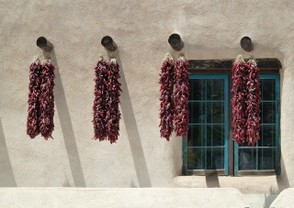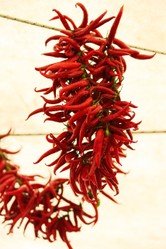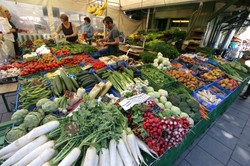Should you decide to freeze some of your crop, you will discover that there are a number of ways that this can be done, ranging from using dry ice to par boiling prior to freezing. Having tried many of the techniques available, I now have two ways of freezing chillies depending on how I will later use them.
A great way to freeze chillies that will later be included in dishes such as curries, is to first blend them to a puree. After they have been blended, simply scoop the mixture into the compartments of an ice-cube tray and freeze. When you need to use them, just add one of the cubes to the dish you are cooking, you do not need to defrost as they will melt during the cooking process.
If, on the other hand, you like to add whole or chopped fruits to a dish such as salads, you can simply cut off the stalk and calyx and freeze them whole.There's no need to put them in bags, as the air that's retained in the bags often leads to the chillies becoming mushy after they've been defrosted. If freezing chillies in this way, however, it is better to chop or slice them while they are still frozen.











 A Colorful Journey: Comparing and Contrasting Mexican Folk Art With Polish Folk Arton 09/05/2024
A Colorful Journey: Comparing and Contrasting Mexican Folk Art With Polish Folk Arton 09/05/2024
 Exploring Traditional Japanese Tapestry Landscape Art: A Window into Nature’s Serenityon 09/01/2024
Exploring Traditional Japanese Tapestry Landscape Art: A Window into Nature’s Serenityon 09/01/2024
 Are Border Collies Really the Smartest Dog Breed?on 08/20/2024
Are Border Collies Really the Smartest Dog Breed?on 08/20/2024
 A Writer's Guide To Wizzley- A Gem of A Bookon 04/10/2013
A Writer's Guide To Wizzley- A Gem of A Bookon 04/10/2013


Comments
Your wizzley about Mexican and Polish folk-art parallels comes to mind here with dried, preserved chilies.
The aforementioned chilies do not dwell natively in Polish cultivated and non-cultivated stretches. But green chives and onions do!
Wouldn't that make quite a stunning, tasty dish for Mexican chilies and Polish chives and onions to wend their way onto serving ware with your Mexican and Polish folk-art designs?
Chilies add such adventurous, aesthetic amusement with their attractiveness as growing and harvested plants.
Resource efficiency always catches my attention.
Is there a freshness, an expiration date beyond which dried, preserved chilies hanging from plant hooks or positioned on doors might not be mixed safely with other ingredients for spicy meals?
Dried, preserved chilies act beautifully as Advent-Christmas-New Year decoration and food.
But does its beautiful red not also defer to Saint Valentine Day decorations?
These chilies also might match nicely if made up nicely as spicy drinks and foods!
Online sources associate chili stems with the same culinary applications as the whole chili.
Chili stems correlate with mineral- and vitamin-containing comestibles.
Might there be more than chili-stem curries, powders, salads and soups?
What about chili-stem drinks and sauces?
Thank you for your comment below, in answer to my previous observation and question.
That's a great idea about initiating the next generation of chili plants by way of chili seeds.
Is there anything culinary to integrate the chili-plant stems?
Hi DerdriuMarriner!
Chilli seeds can be utilised for more chilli plants, and the best time to plant (starting indoors) is from January to March for a supply on tap
The second subheading, Drying chilies in the oven, mentions moving stem and perhaps seeds from a grease-proof lined baking tray.
Might there be something culinary, something horticultural for seeds and stems that otherwise might be mixed with landfill trash?
You're welcome- Freezing them in ice cube compartments is also really handy! :)
We love peppers, now I know how to dry them. Great guide and thank you. :)K
I agree Cazort, there's nothing like have your own crop of chilies at hand whenever you need them. Generally speaking, I stick to cayenne and Haberneros. At the moment though, I have to admit that freezing chillies works well for me- it's really easy and then you can just throw a frozen chilli cube into whatever you're cooking.